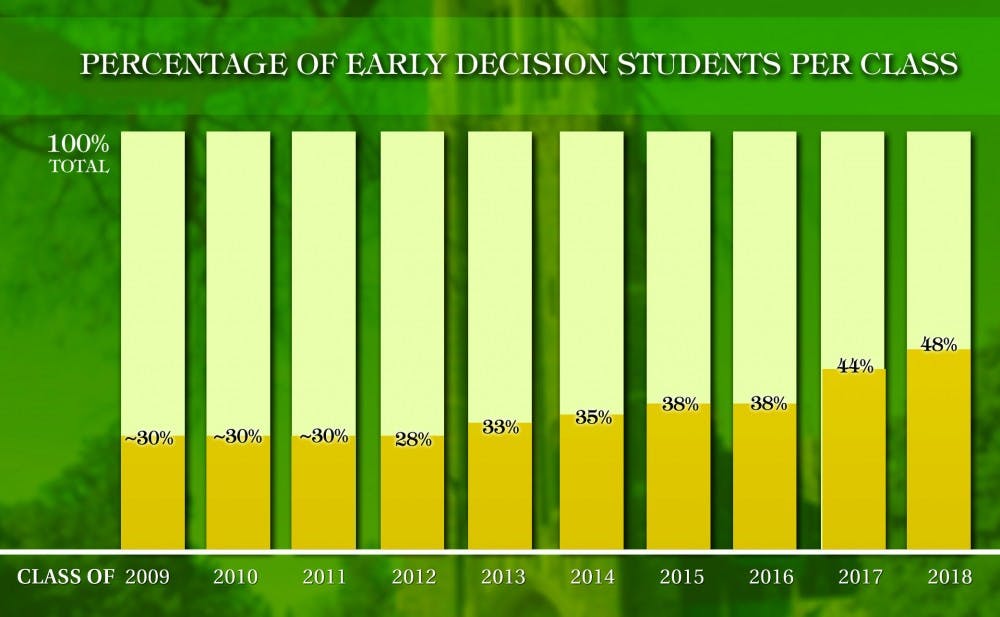A decade ago, a little more than a quarter of Duke students were admitted via early decision.
Now, that figure has nearly doubled—with the University filling almost half of its incoming class through early decision. But although the number of students admitted early has increased steadily in recent years, it may have reached a plateau for the time being.
"There's something psychological about the 50 percent mark," Dean of Undergraduate Admissions Christoph Guttentag said. "I don't have as a goal hitting 50 percent.... I like, in general, the idea of having over half of the class available to students who are applying regular decision."
In December, the University admitted 815 students early—meaning that a record 48 percent of the Class of 2019 will come from early decision. This breaks the previous high set by the Class of 2018, with 47 percent admitted early.
These numbers are a notable change from those posted a decade ago, when the University's proportion of early admits fluctuated between 25 and 30 percent. Even as peer schools such as the University of Pennsylvania and the University of Chicago began to admit increasing numbers of students early, Duke maintained that it would not change its policy.
“In limiting the size of the entering groups, we are in the minority among selective colleges,” Guttentag told The Chronicle in 2002, noting that Duke aimed to keep its percentage of early admits at or under 30 percent.
But as the University received more and more early applicants throughout the mid 2000s, the strength of the applicant pool increased, Guttentag said—and Duke admitted more of its class early, breaking the 35 percent mark with the Class of 2014 and the 40 percent mark with the Class of 2017.
In the years to come, though, the proportion of students admitted early may hold steady. Although the University values early decision students for their dedication to the school, Duke does not necessarily want more than half of its classes to be admitted early, Guttentag noted.
"I'm pretty comfortable with where we are—if things don't change dramatically, we'll stay roughly where we are," Guttentag said in a recent interview. "But if the early decision pool were to expand dramatically and be dramatically stronger, I'm not going to stop just short of 50 percent just for the sake of doing so."
The Class of 2019's proportion of early admits is on par with that of most peer schools with binding early decision programs. Dartmouth College admitted 41 percent of its class early, Northwestern University, 49 percent, and the University of Pennsylvania, 54 percent.
A frequent criticism of admitting large proportions of students through binding early decision programs is that applicants in need of financial aid are put in an unfair position. For students who will need to compare financial aid packages from different schools to maximize their aid, applying early often is not a possibility—something that Duke recognizes, Guttentag said.
"The regular decision pool is always going to be economically more diverse than the early decision pool," Guttentag said. "However, from my perspective in the end what matters is what the entering class as a whole is like.... We're definitely aware of the economic difference between early decision and regular decision, and that's one of the reasons why—unless things are dramatically different—I don't think we'll get much higher [in early admits.]"
The Class of 2019 represents not only a new record for proportion of early admits, however—it also is the first year that applicants have an optional essay question where they can share information about what makes them unique and how they can contribute to the diversity of the class.
From the early applications, the admissions office feels the new question is a success, Guttentag said. Nearly all students wrote a response.
"Some students who answer it seem to be stretching to find something to say, but for the most part it's a wonderful opportunity to learn a little more about applicants that otherwise wouldn't come through," Guttentag said. "We were hoping that would happen, that students would talk about their own perspectives, their points of view, their culture in that question."
Get The Chronicle straight to your inbox
Signup for our weekly newsletter. Cancel at any time.

